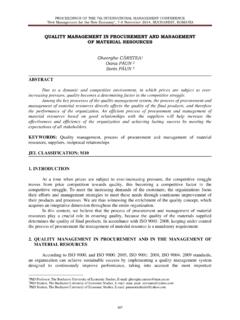Transcription of Ten Characteristics of a Good KPI - Gerke
1 Copyright 2007 Gerke & Associates Ten Characteristics of a Good KPI There s a lot of talk these days about key performance indicators (KPIs). They are the backbone of scorecards and dashboards, which have become an irresistible way for organizations to present performance information to executives and staff. Unfortunately, Business Intelligence developers seem to focus more on creating visual metaphors (dials, gauges, arrows, etc.) than understanding what constitutes a good KPI that delivers long term value to the organization. Part of the problem is that people use the terms KPI and metric interchangeably.
2 This is wrong. A KPI is a metric, but a metric is not always a KPI. The key difference is that KPIs always reflect strategic value drivers whereas metrics may represent the measurement of any business activity. When developing KPIs for scorecards or dashboards, you should keep in mind that KPIs possess 10 distinct Characteristics . Although metrics may exhibit some of these Characteristics , good KPIs possess all of them. #1. KPIs Reflect Strategic Value Drivers KPIs reflect and measure key drivers of business value. Value drivers represent activities that, when executed properly, guarantee future success.
3 Value drivers move the organization in the right direction to achieve its stated financial and organizational goals. Examples of value drivers might be high customer satisfaction or excellent product quality. In most cases, KPIs are not financial metrics. Rather, KPIs reflect how well the organization is doing in areas that most impact financial measures valued by shareholders, such as profitability and revenues. As such KPIs are leading not lagging indicators of financial performance . In contrast, most financial metrics (especially those found in monthly or annual reports) are lagging indicators of performance .
4 #2. KPIs Are Defined by Executives Executives define value drivers in planning sessions which determine the short and long term strategic direction of the organization. To get the most from these value drivers, executives need to define how they want to measure their organizations performance against these drivers. Unfortunately, too many executives terminate strategic planning sessions before theyCopyright 2007 Gerke & Associates 2 define and validate these measurements, otherwise known as KPIs. The results are predictable, giving proof to the adage, You can t manage what you don t measure.
5 #3. KPIs Cascade throughout an Organization Every group at every level in every organization is managed by an executive whether or not the person carries that title. These executives may be known as divisional presidents, managers, directors, or supervisors, among other things. Like the CXOs, these executives also need to conduct strategic planning sessions that identify the key value drivers, goals, and plans for the group. At lower levels, these elements may be largely defined and handed down by a group higher in the hierarchy.
6 However, in every case, each group s value drivers and KPIs tie back to those at the level above them, and so on up to the level of the CXOs. In other words, all KPIs are based on and tied to the overarching corporate strategy and value drivers. In this way, top level KPIs cascade throughout an organization, and the data captured by lower level KPIs roll up to corporatewide KPIs. This linkage among all KPIs, which can be modeled using strategy mapping software, supports flexible analysis and reporting at any level of granularity at any level of the organization.
7 #4. KPIs Are Based on Corporate Standards The only way cascading KPIs work is if an organization has established standard measurements. This is deceptively hard. It can take organizations months if not years to hash out the meaning of key measures or entities, such as net profit or customer. Functional representatives at a major airline spent months trying to agree on the meaning of flight and segment and their entire analytical infrastructure was put on hold until they achieved consensus. In some cases, organizations can only agree to disagree and use metadata to highlight the differences in reports.
8 Only with enough top executive support can organizations overcome the political obstacles associated with standardizing definitions for commonly used KPIs. #5. KPIs Are Based on Valid Data When pressed, most executives find it easy to create KPIs for key value drivers. In fact, most industries already have a common set of metrics for measuring future success. Unfortunately, knowing what to measure and actually measuring it are two different things. Before executives finalize a KPI, they need to ask a technical analyst if the data exists to calculate the metric and whether it s accurate enough to deliver valid results.
9 Often, the answer is no! In that case,Copyright 2007 Gerke & Associates 3 executives need either to allocate funds to capture new data or clean existing dirty data. Or they need to revise the KPI. Providing cost estimates for each approach will help executives decide the best course of action. #6. KPIs Must Be Easy to Comprehend One problem with most KPIs is that there are too many of them. As a result, they lose their power to grab the attention of employees and modify behavior. According to TDWI research, the median number of KPIs that organizations deploy per user is seven.
10 More KPIs than this makes it difficult for employees to peruse them all and take requisite action. In addition, KPIs must be understandable. Employees must know what s being measured, how it s being calculated, and, more importantly, what they should do (and shouldn t do) to positively affect the KPI. This means it is not enough to simply publish a scorecard you must train individuals whose performance is being tracked and follow up with regular reviews to ensure they understand and are acting accordingly. As one IT manager said, Measurements without meetings is useless.







